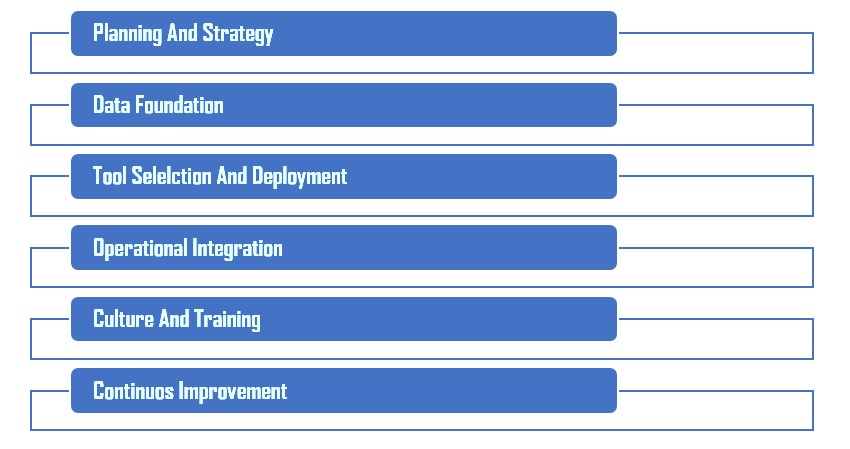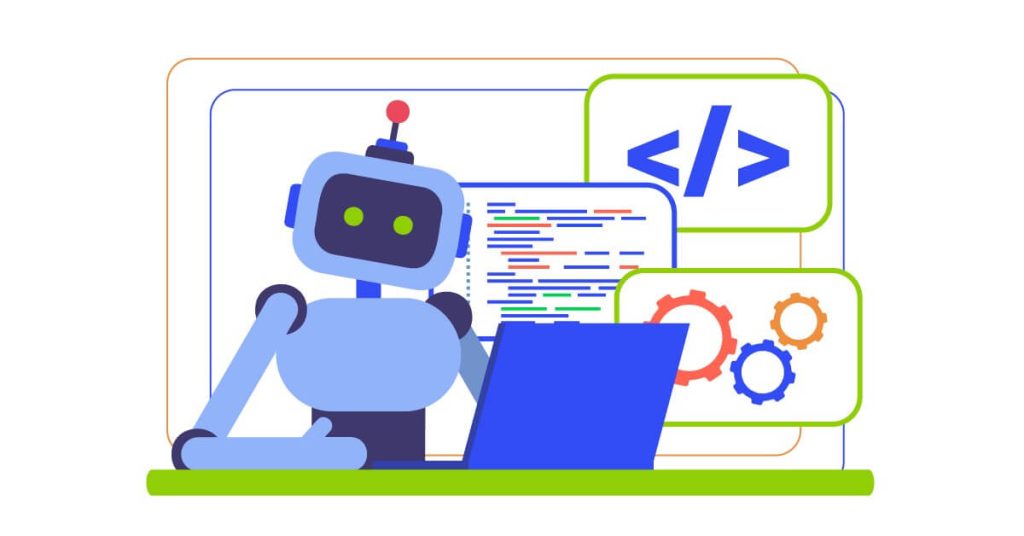Old-style IT operations are losing their edge in today’s digital-first landscape. IT teams must focus on adopting present-day, useful technologies to help their teams work better and smarter. Failing to adapt could leave their strategies outdated and ineffective.
What Is AIOps?
Artificial Intelligence for IT Operations or AIOps is defined as the advanced analytic and IT operation management solution of AI capabilities. It leverages generative AI services, NLP, and machine learning to automate and enhance IT operation tasks. It uses data analytics to automate various IT operations enabling intelligent and quick decision-making.
The Evolution Of IT Operations
Gartner has introduced AIOps in 2016. It was originally called Algorithmic IT Operations. The name was later changed to Artificial Intelligence for IT Operations to reflect its growing impact and use cases across the industry.
Highlights of The Transformative Role Of AI:
Mainframe Era from 1960s-1980s
- Centralized computing focused on batch processing.
Client-Server Model-1990s
- Enabled flexibility and resource accessibility.
Internet Revolution- 2000s
- Introduction of global connectivity and real-time or live interactions.
Cloud Computing- 2010
- Brought scalable resources and remote access.
DevOps and Automation: 2010-Present
- Accelerated delivery cycles with automation and integration.
Key Components Of AIOps Include:
Data Collection:
- Aggregates operational data from logs, metrics, and events.
Data Analysis:
- Identifies patterns and anomalies using machine learning.
Automation:
- Streamlines repetitive tasks, reducing manual intervention.
Predictive Analytics:
- Anticipates potential issues, enhancing system resilience.
How Did AIOps Emerge?
IT systems and the rise of multi-cloud and hybrid infrastructure got too complex for manual management. It necessitated the use of smart automation tools to handle the workload. AIOps was born out of this demand, fueled by advancements in:
Cloud Computing:
- Scalable infrastructure revolutionized operations.
Big Data:
- Required advanced analytics for actionable insights.
DevOps:
- Increased the need for automation and real-time collaboration.
AIOps platforms look at everything happening, spot potential problems, and help fix them before they cause trouble. Early adoption by enterprises across various sectors leveraged AIOps to fulfill their unique operational challenges.
Why Is AIOps Important Today?
The massive amount of data from IT systems has made old monitoring methods unreliable and inefficient. AIOps are crucial to meet IT operational excellence and customer satisfaction as many companies are directed towards AI-driven solutions in this digital-first world.
AIOps addresses this by:
- Offering AI and ML-driven real-time analysis to improve efficiency.
- Automating routine tasks and reducing downtime.
- Enhancing predictive capabilities to prevent disruptions.
AIOps are important today for companies to:
- Streamline IT operations by automating routine tasks.
- Enhance customer experience with quicker issue resolution.
- Reduce operational costs by providing actionable insights with a lean team.
- Support cloud migration with real-time monitoring.
- Enable proactive service management by predicting disruptions.
- Shorten problem mitigation time through faster issue detection.
Benefits Of AIOps
AIOps is improving how businesses manage their IT environments. Here’s how it can help your organization:
Reducing Downtime
AIOps helps spot and fix issues early before they cause major disruptions. It ensures systems stay up and running with minimized downtime.
Boosting Operational Confidence
By automating repetitive tasks like monitoring and incident management, AIOps make IT operations more reliable, so teams can feel confident that things will run smoothly.
Managing Vulnerabilities Faster
AIOps speeds up root cause analysis, helping teams quickly pinpoint and resolve issues, and reducing the impact of potential vulnerabilities on your systems.
Maximizing Resources
With AIOps automating manual tasks, your business can scale efficiently without having to hire more staff. This helps optimize your resources and keeps costs down.
Driving New Ideas
With the automation of routine IT tasks, AIOps provides your team with more time to focus on bringing new strategies for business growth.
Breaking Down Intricacies
It helps spot potential problems early, assess their impact, and allows teams to address them quickly. Managing complex IT environments is easier with AIOps.
Key Features Of AIOps
Increased Efficiency:
AIOps automates monitoring and troubleshooting tasks saving time and resources for more crucial work.
Proactive Problem Detection:
AIOps catches issues before they grow, preventing system downtime and improving performance.
Faster Incident Response:
AI-enabled incident management quickly detects diagnoses, and resolves problems, minimizing disruptions.
Enhanced Security:
Real-time anomaly detection boosts security by identifying threats early and keeping the systems safe.
How Does AIOps Impact Enterprises?
AIOps helps enterprises do more with automated tasks and data-driven decisions offering the following benefits.
Scalability
As your business expands, your IT operations can easily keep pace. It allows you to scale your operations without the need for additional staff. AIOps efficiently handles the increasing demands of IT environments, ensuring seamless growth.
Saving Time and Money
By handling repetitive tasks automatically, enterprises can do more with less. This means better productivity without bloating the budget or burning out your people.
Making Better Choices
With real-time data, AIOps helps businesses make smarter decisions by optimizing resources and improving processes. Instead of guessing or making assumptions, companies can trust accurate data to guide their choices and drive better outcomes.
Reduced downtime
Catch problems before they become disasters. Like regular maintenance, spotting issues early keeps everything running smoothly and prevents unexpected breakdowns.
Getting More Done
When routine tasks are handled automatically, your IT team can focus on projects that matter. This means faster responses and better use of everyone’s time and talent.
Staying Ahead of Problems
Instead of constantly putting out fires, enterprises can spot potential issues early. This means fewer emergencies and more planned, careful solutions.
Fixing Things Faster
When problems do occur, they’re solved more quickly. Your team can pinpoint and address issues rapidly, keeping business moving without lengthy disruptions.
Working Better Together
Everyone sees the same information and works from the same playbook. This breaks down the walls between different teams and helps people collaborate more effectively to solve problems.
AIOps Use Cases Across Industries
Industries implementing AIOps
The following industries implement AIOps to enhance the efficiency of IT Operations for various use cases.
Banking and Financial Services, And Insurance.
- Transaction monitoring and fraud detection
- Compliance monitoring and reporting
- Risk assessment automation
- Real-time security threat detection
- Payment processing optimization
- Customer service automation
- Infrastructure performance monitoring
Healthcare And Life Sciences
- Electronic Health Record (EHR) system optimization
- Medical device monitoring
- Patient data security management
- Clinical workflow automation
- Resource scheduling optimization
- Regulatory compliance monitoring
- Telehealth platform management
Retail And E-Commerce
- Inventory management systems
- Point-of-sale system monitoring
- E-commerce platform optimization
- Customer experience monitoring
- Supply chain analytics
- Payment gateway monitoring
- Mobile app performance management
Manufacturing
- Production line monitoring
- Quality control automation
- Equipment maintenance prediction
- Supply chain optimization
- Inventory tracking
- Energy usage optimization
- Production scheduling
Public Sector
- Citizen service platforms
- Public infrastructure monitoring
- Emergency response systems
- Data security management
- Resource allocation optimization
- Document management systems
- Public service delivery monitoring
Media And Digital
- Content delivery optimization
- Streaming service monitoring
- Digital asset management
- User experience monitoring
- Platform performance optimization
- Content distribution networks
- Analytics and reporting systems
Small And Medium-Sized Enterprises
- IT infrastructure monitoring
- Cloud resource optimization
- Security management
- Business application monitoring
- Backup and recovery automation
- Performance optimization
- Cost management systems
Large Enterprises
- Multi-cloud environment management
- Global infrastructure monitoring
- Enterprise application integration
- Cross-platform security management
- Service delivery optimization
- Resource allocation automation
- Compliance and governance monitoring
Telecommunications
- Network performance monitoring
- Service quality management
- Customer experience optimization
- Infrastructure capacity planning
- Security threat detection
- Service delivery automation
- 5G network optimization
Energy And Utilities
- Grid performance monitoring
- Energy distribution optimization
- Resource utilization tracking
- Predictive maintenance
- Compliance monitoring
- Customer service automation
- Smart meter management
Key Players In AIOps Adoption
AIOps platforms uplift every industry by making IT operations smarter and more efficient. For example, Netflix. They use AIOps with ML to monitor their systems in real-time, fixing issues quickly to deliver seamless customer or viewer satisfaction.
Several companies are leading the AIOps revolution. The following innovators are setting the stage for a more proactive and reliable IT future.
IBM Corporation:
- Enhancing IT operations with AI and machine learning development for smarter problem-solving.
Cisco Systems Inc.:
- Simplifying network management and bolstering security with advanced analytics.
Splunk:
- Turning machine data into actionable insights for better decisions and smoother operations.
Dynatrace Inc.:
- Offering full-stack monitoring to optimize complex IT environments.
Elastic:
- Combining search and analytics to make sense of IT data and improve management.
Broadcom SA:
- Broadcom provides AIOps solutions that focus on network and security operations, helping organizations streamline their IT processes.
AIOps Vs Other Related IT Practices
| Comparison | Differences |
| AIOps vs. DevOps | DevOps bridges development and operations for faster delivery. AIOps uses AI to enhance IT processes. |
| AIOps vs. MLOps | MLOps focuses on deploying and managing ML models, AIOps applies ML to optimize IT operations. |
| AIOps vs. SRE | SRE automates reliability checks, and AIOps supports it by providing predictive insights from large datasets. |
| AIOps vs. DataOps | DataOps optimizes data pipelines. AIOps leverages this data to detect and resolve IT issues. |
Use Cases Of AIOps:
| AIOps Use Case | Description |
| Application Performance Monitoring (APM) | Collects metrics from complex cloud environments using AI. |
| Root Cause Analysis | Identifies true causes of incidents using AI/ML, beyond surface alerts. |
| Anomaly Detection | Detects unusual patterns quickly to enable faster fixes. |
| Cloud Automation and Optimization | Dynamically scales resources and improves cloud observability. |
| App Development Support | Automates code reviews and detects bugs early in development. |
Other Real-world Use Cases
Use Case 1: Predictive Maintenance In IT Infrastructure
Real-World Problems
- Unexpected Network Downtime:
- Slow Performance:
- Unpredictable Failures
- Uncertain Maintenance:
How AIOps Helps:
AIOps keeps a real-time eye on your IT systems, spotting patterns that could lead to problems. Predicting issues early, lets you act before anything goes wrong—avoiding downtime and keeping everything running smoothly.
Example – Cisco:
- Cisco uses AIOps to spot and fix network issues early, keeping services running smoothly.
Use Case 2: Anomaly Detection And Security Threat Management
Real-World Problems:
- Security breaches go unnoticed in endless data to spot the threats.
- The team wastes time chasing False alarms and overlooks actual attacks.
- Overloaded logs hide critical issues.
- Slow threat responses lead to costly damage.
How AIOps Helps:
AIOps monitors your data around the clock, spotting unusual patterns that could mean a cyberattack. It cuts through the clutter to highlight real threats in real-time.
Example – Splunk:
- Splunk uses AIOps to detect security threats by analyzing system and application logs in real time, improving the detection of breaches.
Use Case 3: Automated Incident Management.
Real-World Problems:
- Your IT team is drowning in issues, leaving critical problems unchecked.
- Fixing incidents manually takes too long, delaying everything else.
- Mistakes happen, making problems worse.
- Routine tasks eat up time, slowing down progress on important projects.
How AIOps Helps:
AIOps takes over routine tasks like categorizing and prioritizing incidents. It automatically detects and resolves recurring issues, making everything run smoothly. No more waiting around for human intervention. AIOps helps you get ahead of problems, solving them before they become bigger.
Example – ServiceNow:
- ServiceNow leverages AIOps to automatically categorize and prioritize IT incidents, improving incident resolution times.
Current And Future Demand For AIOps
AI is already revolutionizing the market by improving revenue growth by 25%.
It is delivering noticeable benefits in key areas like:
- Better cybersecurity and system resilience.
- Improved customer satisfaction and retention.
- More effective marketing strategies.
- Streamlined operations and processes.
- Higher staff productivity.
Current And Future Demands Of AIOps
According to Gartner reports, The AIOps market is rapidly expanding,
- currently valued at $75.93 billion in 2024.
- By 2025, The market is expected to reach with Significant annual growth rate of 38.1%.
- It is projected to exceed $5.22 trillion by 2037.
- AIOPs Market to Reach USD 213.66 Billion by 2033.
According to Statista reports,
- CAGR 2024-2030 – The market is projected to grow at an annual rate of 28.46%, reaching a value of $826.70 billion by 2030.
The Number Speaks For Themselves:
| Gen AI | Cuts support time by 50% |
| Multi-Cloud Management | Saves 70% on cloud costs |
| Self-Fixing Systems | Reduces downtime by 90% |
| Smart Monitoring | Catches 95% of problems early |
| All-in-One Tools | Cuts alert noise by 90% |
Key Drivers Of AIOps Demand
The following factors led to the rise of AIOps.
Growing Data Volume & Speed
- Rapid growth in huge volume data generation and processing speed requires efficient management and real-time monitoring.
Complex IT Environments:
- As IT infrastructures grow more complex, enterprises need advanced solutions for system management and improved performance.
Proactive Operations:
- Companies seek to predict and resolve IT issues proactively reducing downtime and optimizing performance.
Digital Transformation demand:
- Businesses are adopting digital solutions to stay competitive. It has driven the demand for more efficient IT management through AIOps.
Complex Cloud and Distributed Systems:
- There is a rise and growth of cloud infrastructures and distributed systems. Managing operations became challenging, creating a demand for smarter monitoring solutions.
Real-Time Analytics and Automation:
- To run IT operations smoothly and efficiently, organizations require immediate insights and automated responses, driving demand for real-time data through AIOps.
Points To Be Taken Care Of While Implementing AIOps

Planning and Strategy
- Define clear goals for AIOps, like reducing downtime or improving MTTR.
- Choose a specific scope to focus on initially, such as critical infrastructure or high-priority domains.
- Ensure stakeholder buy-in, including IT teams and management.
Data Foundation
- Gather data from all sources, like log files, monitoring tools, and configurations.
- Clean, tag, and standardize the data to make sure it’s accurate and consistent.
Centralized Data Repository
- Consolidate all data into a centralized data lake for better analysis and cross-correlation.
- Ensure data is accessible for running machine learning algorithms and gaining insights.
Tool Selection & Integration
- Select AIOps vendors that work well with your current tools and business specifics.
- Make sure the AIOps tool can easily integrate with your existing IT systems and security tools.
Deployment Model
- Select SaaS, on-premises, or hybrid deployment models based on your business specifics.
- Make sure scalability, security, and compliance are in place when you select the deployment model.
Phased Rollout
- Begin with a small test or pilot project to see how well the tool works.
- Collect feedback from stakeholders and make adjustments before full deployment.
Data Quality and Accuracy
- Focus on ensuring high-quality, accurate data as a foundation for AIOps success.
- Identify gaps early to prevent issues during decision-making and predictions.
Alert Management and Automation
- Remove alert noise by filtering out false alarms and prioritizing the real alerts.
- Automate redundant tasks to save time and effort.
Operational Integration
- Integrate AIOps with existing IT operations workflows to improve overall efficiency.
- Continuously monitor and refine automated remediation processes to improve response times.
Change Management
- Address concerns and resistance by clearly communicating the benefits of AIOps.
- Support employees with training and help them understand the impact on workflows and processes.
Skill Development and Training
- Provide ongoing training to develop key data scientist and machine learning skills.
- Learning continuously for IT teams to keep up with AIOps advancements and best practices.
Monitoring continuously.
- Track performance metrics continuously such as MTTR, alert reduction, and incident resolution.
- Continuously refine algorithms, update training data, and expand the scope of AIOps to cover more areas.
Security Measures In AIOps
We need to follow the best practices to protect sensitive data by updating models regularly, implementing access control mechanisms, and more.
| Challenges | Security Measures |
| Data Privacy | Encryption, Access Controls |
| Threat Detection | AI-Powered Monitoring |
| Compliance | Automated Rule Checking |
| Integration | Connect All Security Tools |
| Human Error | Regular Staff Training |
| Misconfiguration | Regular Audits and Checks. |
Risks When Security Measures Are Not Taken Care Of.
| Risk | Impact |
| Data Breaches | Compromised Sensitive information. |
| Malware Infections | Infected systems, leading to data theft, extortion, and damage. |
| Vulnerabilities | Exploitation of Weaknesses in software, hardware, or processes. |
| Data Leaks | Confidential data can be accidentally exposed. |
| Legal Liability | Companies may face legal damages or reputation loss due to negligence in data handling. |
| Phishing Attacks | Hackers can steal personal information by impersonating the source details. |
| Compliance Enforcement | Not meeting compliance and regulation standards can result in fines and penalties. |
The Benefits Of AIOps In Cyber Security:
| Benefit | Impacts |
| Automated Real-Time Threat Detection | AIOps uses real-time data analysis to quickly detect and minimize threats. |
| Enhanced Incident Response | AIOps automate responses, helping teams act faster and prevent damage. |
| Reduction in False Positives | Filters out false alarms, improving accuracy and saving time for security teams. |
| Improved Scalability and Efficiency | AIOps scales quickly to manage large data and complex environments, maintaining protection during attacks. |
| Enables Predictive Analytics | Uses historical and real-time data to predict and prevent threats. |
| Enhanced Data Protection | Tracking and Monitoring continuously by AIOps improves security for sensitive data. |
| Better Compliance | Ensures compliance with regulations, minimizing legal risks. |
| Real-Time Monitoring | Provides continuous system monitoring to detect and address threats instantly. |
| Reduced Operational Costs | Automates tasks, cutting down manual effort and lowering operational expenses. |
Discover Aegis’ AIOps Implementation Success Stories.
Case Study 1: Improving IT Operations For A Retail Business
Problem:
A prominent retail business company approached Aegis saying “We have a tough time managing large volumes of data across our multiple e-commerce platforms and physical stores. System outages during peak shopping periods causing poor customer experiences directly impacting our sales”
Solution:
- Our Aegis team has successfully integrated AIOps to address our client’s pain points.
- Assessed IT infrastructure to identify potential issues across inventory systems, POS systems, and customer-facing applications.
- Deployed AIOps to monitor and optimize system performance in real-time.
- Used predictive analytics to detect and resolve potential failures before impacting operations.
- Leveraged advanced technologies like machine learning for proactive issue resolution.
- Integrated AIOps with existing tech stack to enhance operational efficiency and reduce downtime.
Results:
- Reduced system outages by 45%.
- Enhanced inventory management and faster stock updates
- Improved customer experience with smoother online and in-store transactions
- Increased sales by reducing downtime during peak hours
Case Study 2: AIOps implementation for Improving Manufacturing Operations.
Problem:
A leading global manufacturing company approached Aegis for IT solutions to address the issues related to frequent equipment failures and unplanned downtime. The client highlighted the issues saying,” We are having delays in production and higher operational costs. The existing monitoring system is compromised without any predictive capabilities.” The company
Solutions offered:
- Assessed machinery and automated systems on the production line.
- Deployed AIOps to monitor and optimize performance in real-time.
- Utilized predictive maintenance algorithms to detect early signs of malfunction.
- Enabled proactive intervention to prevent downtime.
- We have monitored system performance continuously.
Results:
- Downtime reduced by half-50%.
- Extended the life of critical machinery through early maintenance
- Saved millions in repair costs by preventing major failures
Case Study 3: Enhancing Cybersecurity For A Banking Institution
Problem statement:
A leading bank was struggling to spot and respond to cyber threats quickly. The client explained their challenge: “Our traditional security systems trigger too many false alarms, and we can’t effectively detect real cyber threats. We need a solution fast to protect our sensitive financial data from being exposed to risk.”
Solution:
- Integrated AIOps to filter out false alerts and focus on real threats.
- Used machine learning to analyze patterns across transaction data, network activity, and customer interactions.
- Automatically flagged suspicious behavior for immediate attention.
- Enhanced threat detection and minimized alert fatigue.
- Improved overall security response time and accuracy.
Results:
- Improved threat detection accuracy by 70%
- Reduced response time to cybersecurity incidents by 50%
- Enhanced protection of sensitive customer data
- Strengthened compliance with industry regulations
How Aegis Can Support Enterprises With AIOps
Managing extensive IT data can be daunting with traditional practices. That is when Aegis jumps in to integrate AI-powered capabilities like big data, analytics, and machine learning to ease IT operations and enable enterprises to shift from reactive to proactive IT management. Our offerings include:
- Data collection, ingestion, and processing.
- Pattern recognition and anomaly detection.
- Incident correlation and automated remediation.
- Predictive analytics for proactive management.
- AI Consulting Service Management
- Offers over 40 integrations for seamless ITSM, ITOM, and system operations.
Conclusion
In the future, AIOps will integrate smoothly with IT service management (ITSM) tools, enhancing service delivery by automating tasks and speeding up issue resolution. It will also focus on making AI decisions more understandable, allowing IT teams to trust and confidently act on insights.
Additionally, AIOps will prioritize aligning IT operations with business objectives, such as increasing revenue and improving the customer experience, to drive overall business success.
With AIOps, Companies Save $4.8M Annually And Cut IT Workload By 50%. Ready To Transform Your Operations? Contact Aegis Softtech Today!



